Understanding Laws and Their Relationship to Nursing Practice
VerifiedAdded on 2021/04/24
|8
|2954
|29
Essay
AI Summary
This essay explores the critical relationship between laws and nursing practice, with a specific focus on the implications of social media use. It begins by highlighting the increasing prevalence of the Internet and social media, emphasizing both their advantages and disadvantages, particularly concerning freedom of expression and potential legal ramifications. The essay analyzes a scenario involving a student's inappropriate social media post and suggests immediate and subsequent actions to address the situation, including apologies, mediation, and counseling. It emphasizes the importance of time management and responsible social media use for nursing students. Furthermore, the essay discusses the code of conduct for nurses and midwives, highlighting the importance of lawful and professional behaviors, and the consequences of violating these standards. It examines the legal implications of threats and defamation on social media, referencing the use of fake accounts and the role of employers in monitoring online behavior. The essay concludes by reiterating the dual nature of social media and the need for responsible conduct, particularly within the nursing profession, emphasizing the significance of respecting oneself and others to maintain professional integrity and avoid legal consequences.
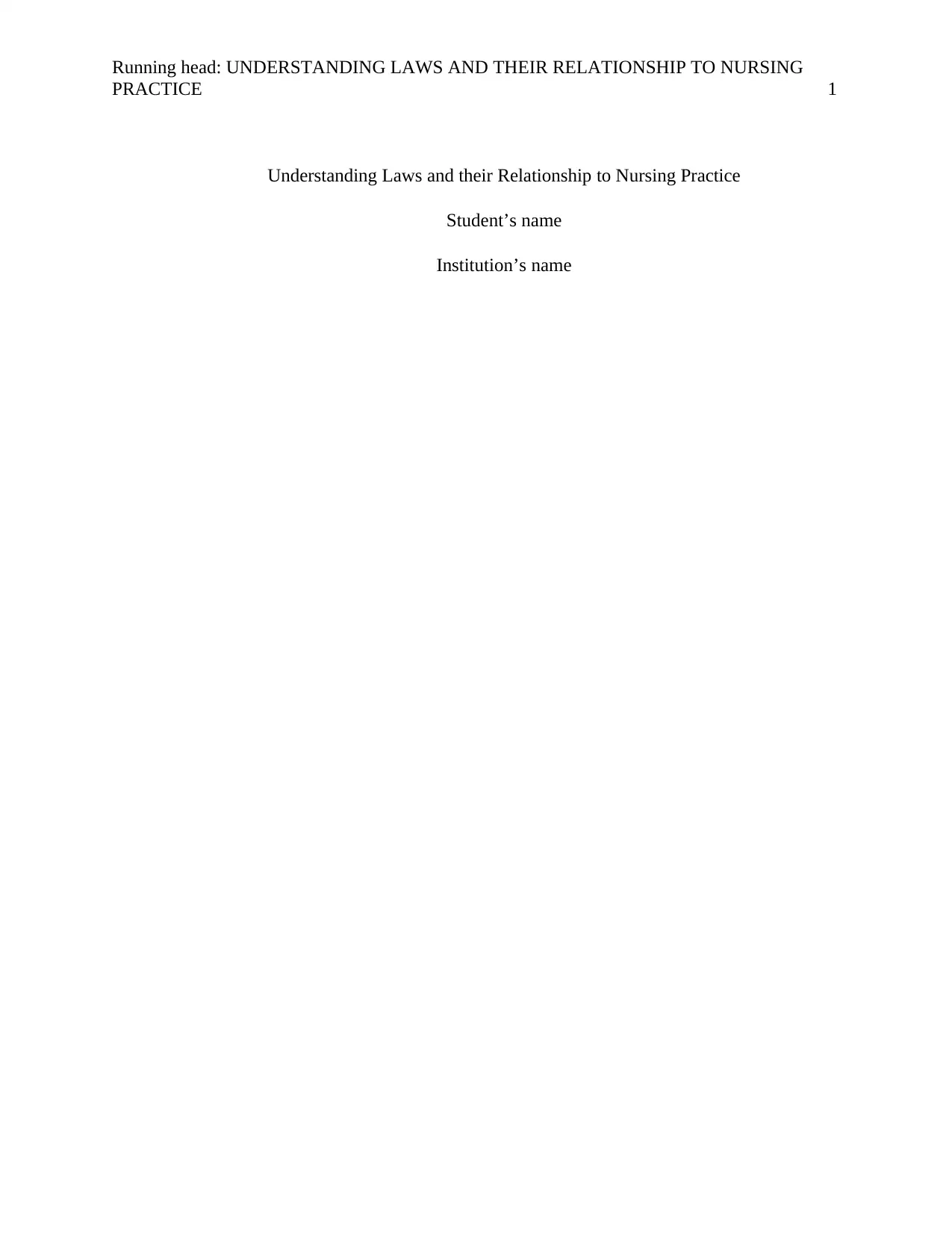
Running head: UNDERSTANDING LAWS AND THEIR RELATIONSHIP TO NURSING
PRACTICE 1
Understanding Laws and their Relationship to Nursing Practice
Student’s name
Institution’s name
PRACTICE 1
Understanding Laws and their Relationship to Nursing Practice
Student’s name
Institution’s name
Paraphrase This Document
Need a fresh take? Get an instant paraphrase of this document with our AI Paraphraser
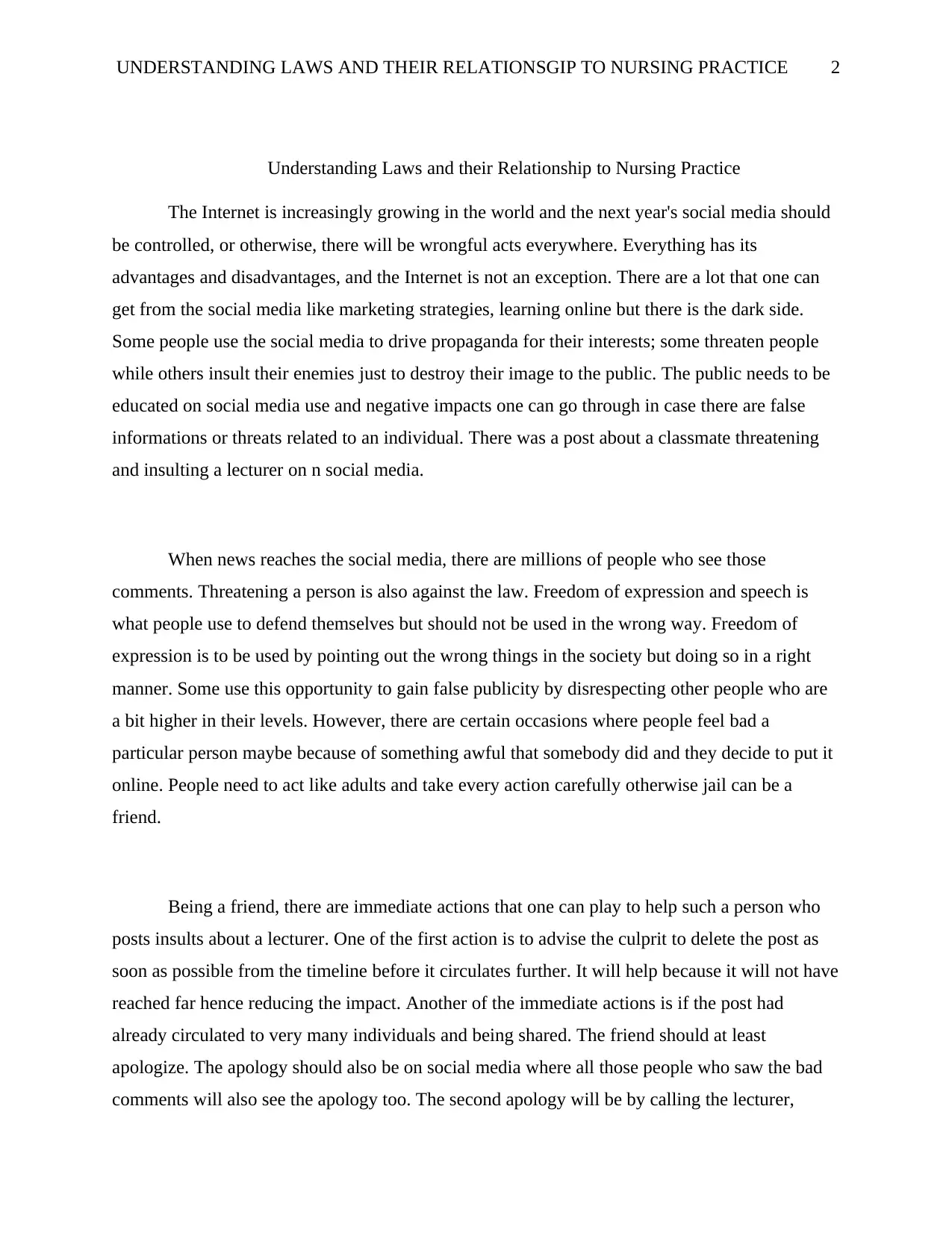
UNDERSTANDING LAWS AND THEIR RELATIONSGIP TO NURSING PRACTICE 2
Understanding Laws and their Relationship to Nursing Practice
The Internet is increasingly growing in the world and the next year's social media should
be controlled, or otherwise, there will be wrongful acts everywhere. Everything has its
advantages and disadvantages, and the Internet is not an exception. There are a lot that one can
get from the social media like marketing strategies, learning online but there is the dark side.
Some people use the social media to drive propaganda for their interests; some threaten people
while others insult their enemies just to destroy their image to the public. The public needs to be
educated on social media use and negative impacts one can go through in case there are false
informations or threats related to an individual. There was a post about a classmate threatening
and insulting a lecturer on n social media.
When news reaches the social media, there are millions of people who see those
comments. Threatening a person is also against the law. Freedom of expression and speech is
what people use to defend themselves but should not be used in the wrong way. Freedom of
expression is to be used by pointing out the wrong things in the society but doing so in a right
manner. Some use this opportunity to gain false publicity by disrespecting other people who are
a bit higher in their levels. However, there are certain occasions where people feel bad a
particular person maybe because of something awful that somebody did and they decide to put it
online. People need to act like adults and take every action carefully otherwise jail can be a
friend.
Being a friend, there are immediate actions that one can play to help such a person who
posts insults about a lecturer. One of the first action is to advise the culprit to delete the post as
soon as possible from the timeline before it circulates further. It will help because it will not have
reached far hence reducing the impact. Another of the immediate actions is if the post had
already circulated to very many individuals and being shared. The friend should at least
apologize. The apology should also be on social media where all those people who saw the bad
comments will also see the apology too. The second apology will be by calling the lecturer,
Understanding Laws and their Relationship to Nursing Practice
The Internet is increasingly growing in the world and the next year's social media should
be controlled, or otherwise, there will be wrongful acts everywhere. Everything has its
advantages and disadvantages, and the Internet is not an exception. There are a lot that one can
get from the social media like marketing strategies, learning online but there is the dark side.
Some people use the social media to drive propaganda for their interests; some threaten people
while others insult their enemies just to destroy their image to the public. The public needs to be
educated on social media use and negative impacts one can go through in case there are false
informations or threats related to an individual. There was a post about a classmate threatening
and insulting a lecturer on n social media.
When news reaches the social media, there are millions of people who see those
comments. Threatening a person is also against the law. Freedom of expression and speech is
what people use to defend themselves but should not be used in the wrong way. Freedom of
expression is to be used by pointing out the wrong things in the society but doing so in a right
manner. Some use this opportunity to gain false publicity by disrespecting other people who are
a bit higher in their levels. However, there are certain occasions where people feel bad a
particular person maybe because of something awful that somebody did and they decide to put it
online. People need to act like adults and take every action carefully otherwise jail can be a
friend.
Being a friend, there are immediate actions that one can play to help such a person who
posts insults about a lecturer. One of the first action is to advise the culprit to delete the post as
soon as possible from the timeline before it circulates further. It will help because it will not have
reached far hence reducing the impact. Another of the immediate actions is if the post had
already circulated to very many individuals and being shared. The friend should at least
apologize. The apology should also be on social media where all those people who saw the bad
comments will also see the apology too. The second apology will be by calling the lecturer,
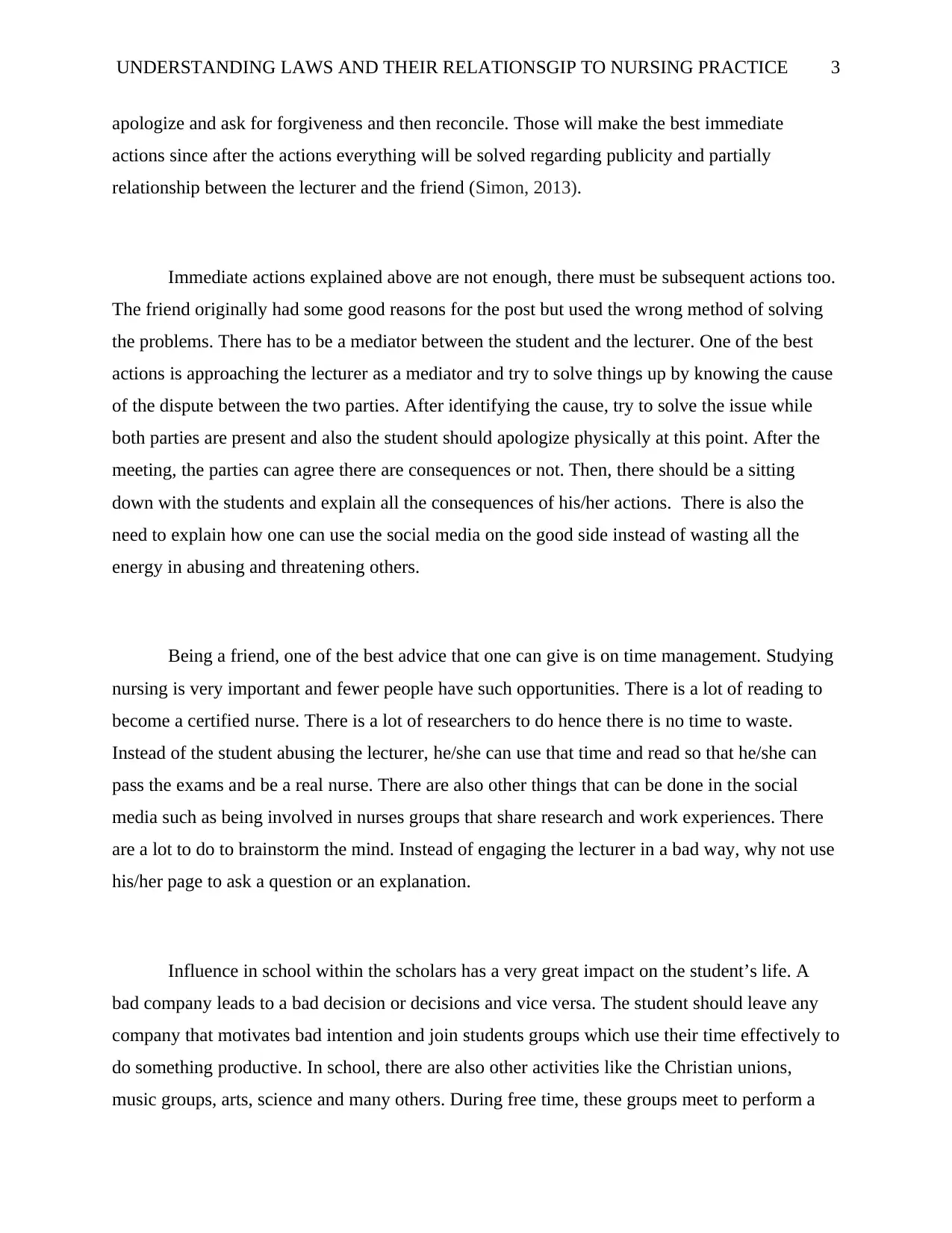
UNDERSTANDING LAWS AND THEIR RELATIONSGIP TO NURSING PRACTICE 3
apologize and ask for forgiveness and then reconcile. Those will make the best immediate
actions since after the actions everything will be solved regarding publicity and partially
relationship between the lecturer and the friend (Simon, 2013).
Immediate actions explained above are not enough, there must be subsequent actions too.
The friend originally had some good reasons for the post but used the wrong method of solving
the problems. There has to be a mediator between the student and the lecturer. One of the best
actions is approaching the lecturer as a mediator and try to solve things up by knowing the cause
of the dispute between the two parties. After identifying the cause, try to solve the issue while
both parties are present and also the student should apologize physically at this point. After the
meeting, the parties can agree there are consequences or not. Then, there should be a sitting
down with the students and explain all the consequences of his/her actions. There is also the
need to explain how one can use the social media on the good side instead of wasting all the
energy in abusing and threatening others.
Being a friend, one of the best advice that one can give is on time management. Studying
nursing is very important and fewer people have such opportunities. There is a lot of reading to
become a certified nurse. There is a lot of researchers to do hence there is no time to waste.
Instead of the student abusing the lecturer, he/she can use that time and read so that he/she can
pass the exams and be a real nurse. There are also other things that can be done in the social
media such as being involved in nurses groups that share research and work experiences. There
are a lot to do to brainstorm the mind. Instead of engaging the lecturer in a bad way, why not use
his/her page to ask a question or an explanation.
Influence in school within the scholars has a very great impact on the student’s life. A
bad company leads to a bad decision or decisions and vice versa. The student should leave any
company that motivates bad intention and join students groups which use their time effectively to
do something productive. In school, there are also other activities like the Christian unions,
music groups, arts, science and many others. During free time, these groups meet to perform a
apologize and ask for forgiveness and then reconcile. Those will make the best immediate
actions since after the actions everything will be solved regarding publicity and partially
relationship between the lecturer and the friend (Simon, 2013).
Immediate actions explained above are not enough, there must be subsequent actions too.
The friend originally had some good reasons for the post but used the wrong method of solving
the problems. There has to be a mediator between the student and the lecturer. One of the best
actions is approaching the lecturer as a mediator and try to solve things up by knowing the cause
of the dispute between the two parties. After identifying the cause, try to solve the issue while
both parties are present and also the student should apologize physically at this point. After the
meeting, the parties can agree there are consequences or not. Then, there should be a sitting
down with the students and explain all the consequences of his/her actions. There is also the
need to explain how one can use the social media on the good side instead of wasting all the
energy in abusing and threatening others.
Being a friend, one of the best advice that one can give is on time management. Studying
nursing is very important and fewer people have such opportunities. There is a lot of reading to
become a certified nurse. There is a lot of researchers to do hence there is no time to waste.
Instead of the student abusing the lecturer, he/she can use that time and read so that he/she can
pass the exams and be a real nurse. There are also other things that can be done in the social
media such as being involved in nurses groups that share research and work experiences. There
are a lot to do to brainstorm the mind. Instead of engaging the lecturer in a bad way, why not use
his/her page to ask a question or an explanation.
Influence in school within the scholars has a very great impact on the student’s life. A
bad company leads to a bad decision or decisions and vice versa. The student should leave any
company that motivates bad intention and join students groups which use their time effectively to
do something productive. In school, there are also other activities like the Christian unions,
music groups, arts, science and many others. During free time, these groups meet to perform a
⊘ This is a preview!⊘
Do you want full access?
Subscribe today to unlock all pages.

Trusted by 1+ million students worldwide
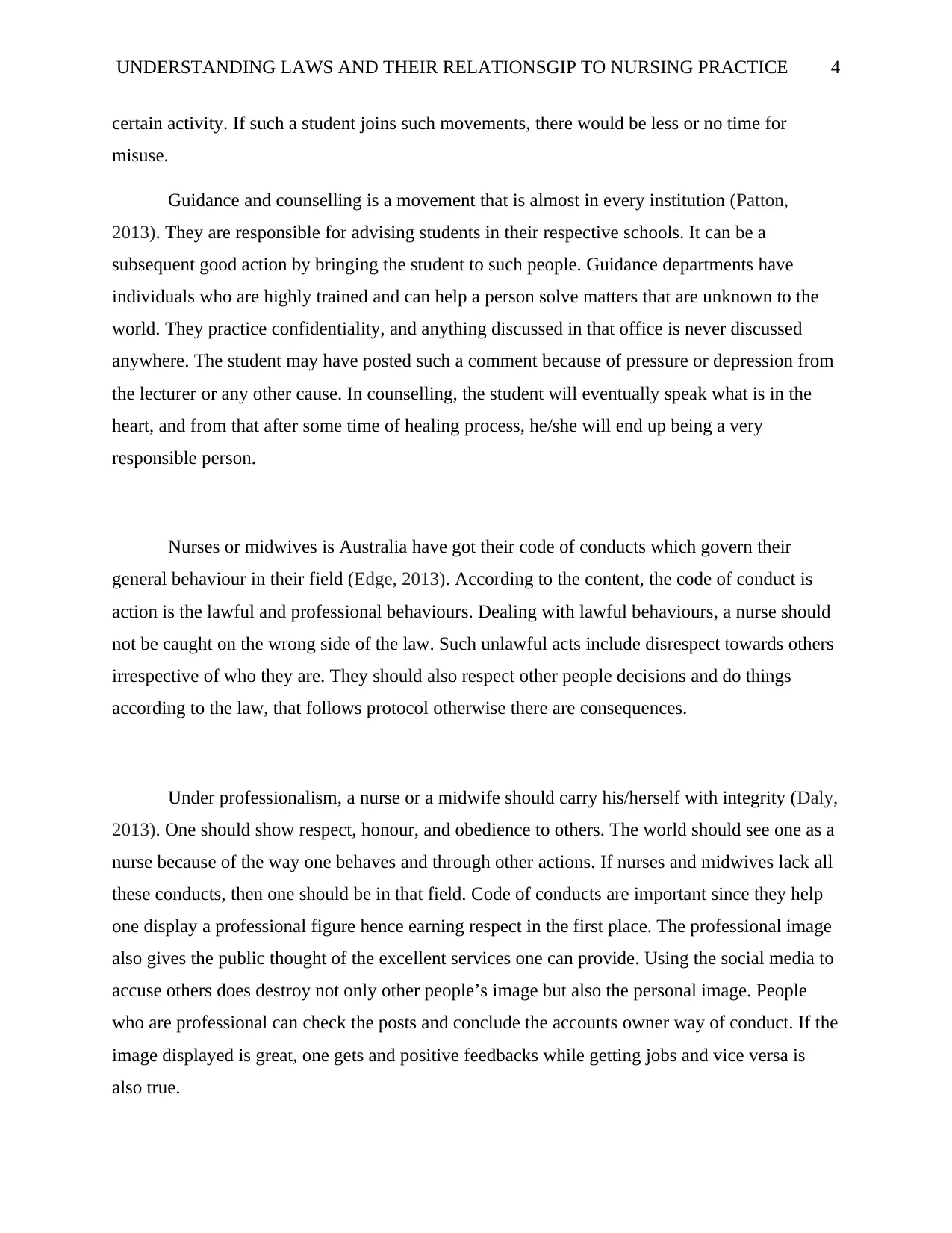
UNDERSTANDING LAWS AND THEIR RELATIONSGIP TO NURSING PRACTICE 4
certain activity. If such a student joins such movements, there would be less or no time for
misuse.
Guidance and counselling is a movement that is almost in every institution (Patton,
2013). They are responsible for advising students in their respective schools. It can be a
subsequent good action by bringing the student to such people. Guidance departments have
individuals who are highly trained and can help a person solve matters that are unknown to the
world. They practice confidentiality, and anything discussed in that office is never discussed
anywhere. The student may have posted such a comment because of pressure or depression from
the lecturer or any other cause. In counselling, the student will eventually speak what is in the
heart, and from that after some time of healing process, he/she will end up being a very
responsible person.
Nurses or midwives is Australia have got their code of conducts which govern their
general behaviour in their field (Edge, 2013). According to the content, the code of conduct is
action is the lawful and professional behaviours. Dealing with lawful behaviours, a nurse should
not be caught on the wrong side of the law. Such unlawful acts include disrespect towards others
irrespective of who they are. They should also respect other people decisions and do things
according to the law, that follows protocol otherwise there are consequences.
Under professionalism, a nurse or a midwife should carry his/herself with integrity (Daly,
2013). One should show respect, honour, and obedience to others. The world should see one as a
nurse because of the way one behaves and through other actions. If nurses and midwives lack all
these conducts, then one should be in that field. Code of conducts are important since they help
one display a professional figure hence earning respect in the first place. The professional image
also gives the public thought of the excellent services one can provide. Using the social media to
accuse others does destroy not only other people’s image but also the personal image. People
who are professional can check the posts and conclude the accounts owner way of conduct. If the
image displayed is great, one gets and positive feedbacks while getting jobs and vice versa is
also true.
certain activity. If such a student joins such movements, there would be less or no time for
misuse.
Guidance and counselling is a movement that is almost in every institution (Patton,
2013). They are responsible for advising students in their respective schools. It can be a
subsequent good action by bringing the student to such people. Guidance departments have
individuals who are highly trained and can help a person solve matters that are unknown to the
world. They practice confidentiality, and anything discussed in that office is never discussed
anywhere. The student may have posted such a comment because of pressure or depression from
the lecturer or any other cause. In counselling, the student will eventually speak what is in the
heart, and from that after some time of healing process, he/she will end up being a very
responsible person.
Nurses or midwives is Australia have got their code of conducts which govern their
general behaviour in their field (Edge, 2013). According to the content, the code of conduct is
action is the lawful and professional behaviours. Dealing with lawful behaviours, a nurse should
not be caught on the wrong side of the law. Such unlawful acts include disrespect towards others
irrespective of who they are. They should also respect other people decisions and do things
according to the law, that follows protocol otherwise there are consequences.
Under professionalism, a nurse or a midwife should carry his/herself with integrity (Daly,
2013). One should show respect, honour, and obedience to others. The world should see one as a
nurse because of the way one behaves and through other actions. If nurses and midwives lack all
these conducts, then one should be in that field. Code of conducts are important since they help
one display a professional figure hence earning respect in the first place. The professional image
also gives the public thought of the excellent services one can provide. Using the social media to
accuse others does destroy not only other people’s image but also the personal image. People
who are professional can check the posts and conclude the accounts owner way of conduct. If the
image displayed is great, one gets and positive feedbacks while getting jobs and vice versa is
also true.
Paraphrase This Document
Need a fresh take? Get an instant paraphrase of this document with our AI Paraphraser
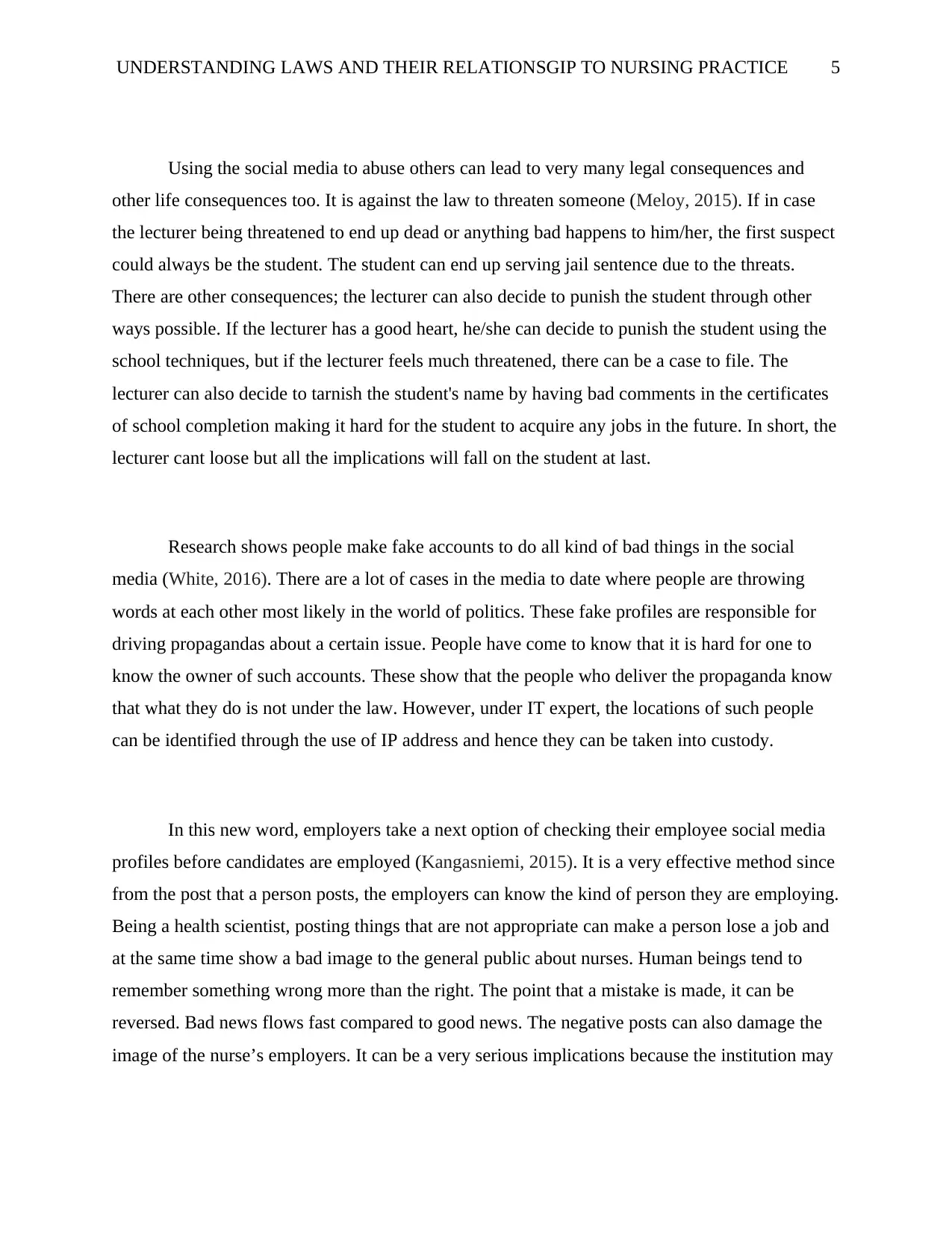
UNDERSTANDING LAWS AND THEIR RELATIONSGIP TO NURSING PRACTICE 5
Using the social media to abuse others can lead to very many legal consequences and
other life consequences too. It is against the law to threaten someone (Meloy, 2015). If in case
the lecturer being threatened to end up dead or anything bad happens to him/her, the first suspect
could always be the student. The student can end up serving jail sentence due to the threats.
There are other consequences; the lecturer can also decide to punish the student through other
ways possible. If the lecturer has a good heart, he/she can decide to punish the student using the
school techniques, but if the lecturer feels much threatened, there can be a case to file. The
lecturer can also decide to tarnish the student's name by having bad comments in the certificates
of school completion making it hard for the student to acquire any jobs in the future. In short, the
lecturer cant loose but all the implications will fall on the student at last.
Research shows people make fake accounts to do all kind of bad things in the social
media (White, 2016). There are a lot of cases in the media to date where people are throwing
words at each other most likely in the world of politics. These fake profiles are responsible for
driving propagandas about a certain issue. People have come to know that it is hard for one to
know the owner of such accounts. These show that the people who deliver the propaganda know
that what they do is not under the law. However, under IT expert, the locations of such people
can be identified through the use of IP address and hence they can be taken into custody.
In this new word, employers take a next option of checking their employee social media
profiles before candidates are employed (Kangasniemi, 2015). It is a very effective method since
from the post that a person posts, the employers can know the kind of person they are employing.
Being a health scientist, posting things that are not appropriate can make a person lose a job and
at the same time show a bad image to the general public about nurses. Human beings tend to
remember something wrong more than the right. The point that a mistake is made, it can be
reversed. Bad news flows fast compared to good news. The negative posts can also damage the
image of the nurse’s employers. It can be a very serious implications because the institution may
Using the social media to abuse others can lead to very many legal consequences and
other life consequences too. It is against the law to threaten someone (Meloy, 2015). If in case
the lecturer being threatened to end up dead or anything bad happens to him/her, the first suspect
could always be the student. The student can end up serving jail sentence due to the threats.
There are other consequences; the lecturer can also decide to punish the student through other
ways possible. If the lecturer has a good heart, he/she can decide to punish the student using the
school techniques, but if the lecturer feels much threatened, there can be a case to file. The
lecturer can also decide to tarnish the student's name by having bad comments in the certificates
of school completion making it hard for the student to acquire any jobs in the future. In short, the
lecturer cant loose but all the implications will fall on the student at last.
Research shows people make fake accounts to do all kind of bad things in the social
media (White, 2016). There are a lot of cases in the media to date where people are throwing
words at each other most likely in the world of politics. These fake profiles are responsible for
driving propagandas about a certain issue. People have come to know that it is hard for one to
know the owner of such accounts. These show that the people who deliver the propaganda know
that what they do is not under the law. However, under IT expert, the locations of such people
can be identified through the use of IP address and hence they can be taken into custody.
In this new word, employers take a next option of checking their employee social media
profiles before candidates are employed (Kangasniemi, 2015). It is a very effective method since
from the post that a person posts, the employers can know the kind of person they are employing.
Being a health scientist, posting things that are not appropriate can make a person lose a job and
at the same time show a bad image to the general public about nurses. Human beings tend to
remember something wrong more than the right. The point that a mistake is made, it can be
reversed. Bad news flows fast compared to good news. The negative posts can also damage the
image of the nurse’s employers. It can be a very serious implications because the institution may

UNDERSTANDING LAWS AND THEIR RELATIONSGIP TO NURSING PRACTICE 6
fail due to lack of trust and later lead to the firing of very many employees as a result of a single
mistake.
In social media, a high percentage of people appreciate bad things compared to good
things (Harding, 2013). Some people become popular by posting things that are of no
importance. For example, people who post motivational talks may be ignored and have fewer
comments or likes compared to people who strike naked. That’s the life in the media. The bad
news has a good taste. Some bloggers now tend to look for irrelevant information that has no
proof, but since they want to attract people, they have to post the propaganda. The friend could
have posted the insult also to gain popularity from the other classmates not purposely to threaten
the lecturer. Furthermore, there is a very small probability that the lecturer saw the post. The
security is social media like Facebook is far from enough. Some people even get through security
passwords and access other people accounts and later leave a post or a video which is totally
negative, and by the time the account owner knows, the post is already in public. The social
media should also take responsibilities by not allowing abnormal posts in their platforms. Every
account owner should be well evaluated before being awarded an account on these social media
platforms to eliminate pseudo accounts. Before signing in, a person should provide useful and
real details so that in case of any post, it will not be hard to identify the person and interrogate.
In conclusion, the social media can be a good thing or bad; it depends on how it is used
(Cohen, 2014). Using the social media to insult and threaten others is not the best way to deal
with disagreements. However, there are different reasons why a person can bring an argument in
the media. Although it is not advisable, guidance is a good method to deal with such people. The
media tolerates such actions, and that’s why it’s hard to stop such practices. Nursing is good
profession hence should be respected. Such professions should have people who respect
themselves and others otherwise they can be fired. Research shows people love bad posts
compared to important posts and people may use the opportunity to be celebrities. There are
serious consequences if one files a case towards a threat from the social media. The people
involved in this kind of drama are the youths. People should avoid the bad use of the media and
utilize it and the time to do meaningful activities.
fail due to lack of trust and later lead to the firing of very many employees as a result of a single
mistake.
In social media, a high percentage of people appreciate bad things compared to good
things (Harding, 2013). Some people become popular by posting things that are of no
importance. For example, people who post motivational talks may be ignored and have fewer
comments or likes compared to people who strike naked. That’s the life in the media. The bad
news has a good taste. Some bloggers now tend to look for irrelevant information that has no
proof, but since they want to attract people, they have to post the propaganda. The friend could
have posted the insult also to gain popularity from the other classmates not purposely to threaten
the lecturer. Furthermore, there is a very small probability that the lecturer saw the post. The
security is social media like Facebook is far from enough. Some people even get through security
passwords and access other people accounts and later leave a post or a video which is totally
negative, and by the time the account owner knows, the post is already in public. The social
media should also take responsibilities by not allowing abnormal posts in their platforms. Every
account owner should be well evaluated before being awarded an account on these social media
platforms to eliminate pseudo accounts. Before signing in, a person should provide useful and
real details so that in case of any post, it will not be hard to identify the person and interrogate.
In conclusion, the social media can be a good thing or bad; it depends on how it is used
(Cohen, 2014). Using the social media to insult and threaten others is not the best way to deal
with disagreements. However, there are different reasons why a person can bring an argument in
the media. Although it is not advisable, guidance is a good method to deal with such people. The
media tolerates such actions, and that’s why it’s hard to stop such practices. Nursing is good
profession hence should be respected. Such professions should have people who respect
themselves and others otherwise they can be fired. Research shows people love bad posts
compared to important posts and people may use the opportunity to be celebrities. There are
serious consequences if one files a case towards a threat from the social media. The people
involved in this kind of drama are the youths. People should avoid the bad use of the media and
utilize it and the time to do meaningful activities.
⊘ This is a preview!⊘
Do you want full access?
Subscribe today to unlock all pages.

Trusted by 1+ million students worldwide
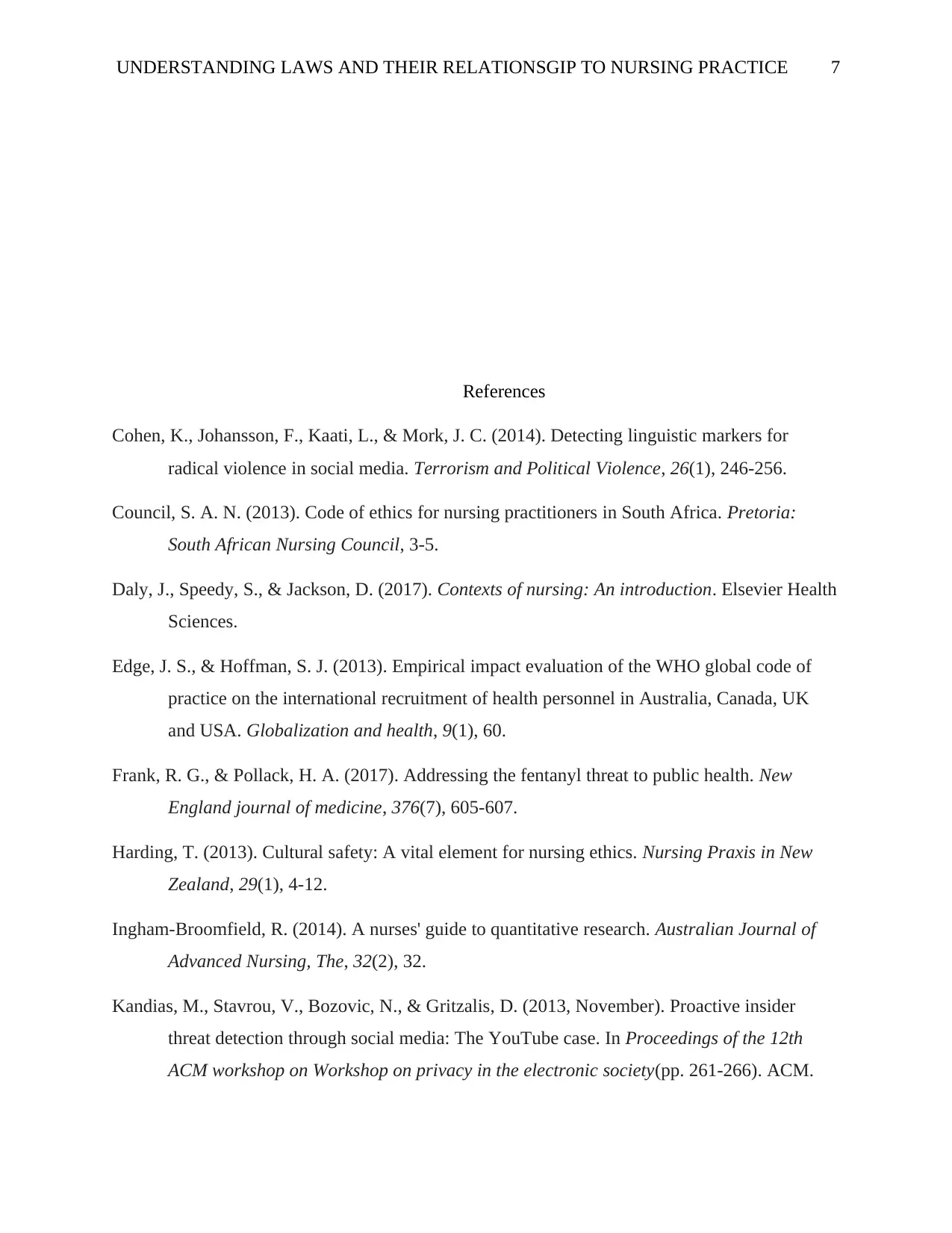
UNDERSTANDING LAWS AND THEIR RELATIONSGIP TO NURSING PRACTICE 7
References
Cohen, K., Johansson, F., Kaati, L., & Mork, J. C. (2014). Detecting linguistic markers for
radical violence in social media. Terrorism and Political Violence, 26(1), 246-256.
Council, S. A. N. (2013). Code of ethics for nursing practitioners in South Africa. Pretoria:
South African Nursing Council, 3-5.
Daly, J., Speedy, S., & Jackson, D. (2017). Contexts of nursing: An introduction. Elsevier Health
Sciences.
Edge, J. S., & Hoffman, S. J. (2013). Empirical impact evaluation of the WHO global code of
practice on the international recruitment of health personnel in Australia, Canada, UK
and USA. Globalization and health, 9(1), 60.
Frank, R. G., & Pollack, H. A. (2017). Addressing the fentanyl threat to public health. New
England journal of medicine, 376(7), 605-607.
Harding, T. (2013). Cultural safety: A vital element for nursing ethics. Nursing Praxis in New
Zealand, 29(1), 4-12.
Ingham-Broomfield, R. (2014). A nurses' guide to quantitative research. Australian Journal of
Advanced Nursing, The, 32(2), 32.
Kandias, M., Stavrou, V., Bozovic, N., & Gritzalis, D. (2013, November). Proactive insider
threat detection through social media: The YouTube case. In Proceedings of the 12th
ACM workshop on Workshop on privacy in the electronic society(pp. 261-266). ACM.
References
Cohen, K., Johansson, F., Kaati, L., & Mork, J. C. (2014). Detecting linguistic markers for
radical violence in social media. Terrorism and Political Violence, 26(1), 246-256.
Council, S. A. N. (2013). Code of ethics for nursing practitioners in South Africa. Pretoria:
South African Nursing Council, 3-5.
Daly, J., Speedy, S., & Jackson, D. (2017). Contexts of nursing: An introduction. Elsevier Health
Sciences.
Edge, J. S., & Hoffman, S. J. (2013). Empirical impact evaluation of the WHO global code of
practice on the international recruitment of health personnel in Australia, Canada, UK
and USA. Globalization and health, 9(1), 60.
Frank, R. G., & Pollack, H. A. (2017). Addressing the fentanyl threat to public health. New
England journal of medicine, 376(7), 605-607.
Harding, T. (2013). Cultural safety: A vital element for nursing ethics. Nursing Praxis in New
Zealand, 29(1), 4-12.
Ingham-Broomfield, R. (2014). A nurses' guide to quantitative research. Australian Journal of
Advanced Nursing, The, 32(2), 32.
Kandias, M., Stavrou, V., Bozovic, N., & Gritzalis, D. (2013, November). Proactive insider
threat detection through social media: The YouTube case. In Proceedings of the 12th
ACM workshop on Workshop on privacy in the electronic society(pp. 261-266). ACM.
Paraphrase This Document
Need a fresh take? Get an instant paraphrase of this document with our AI Paraphraser
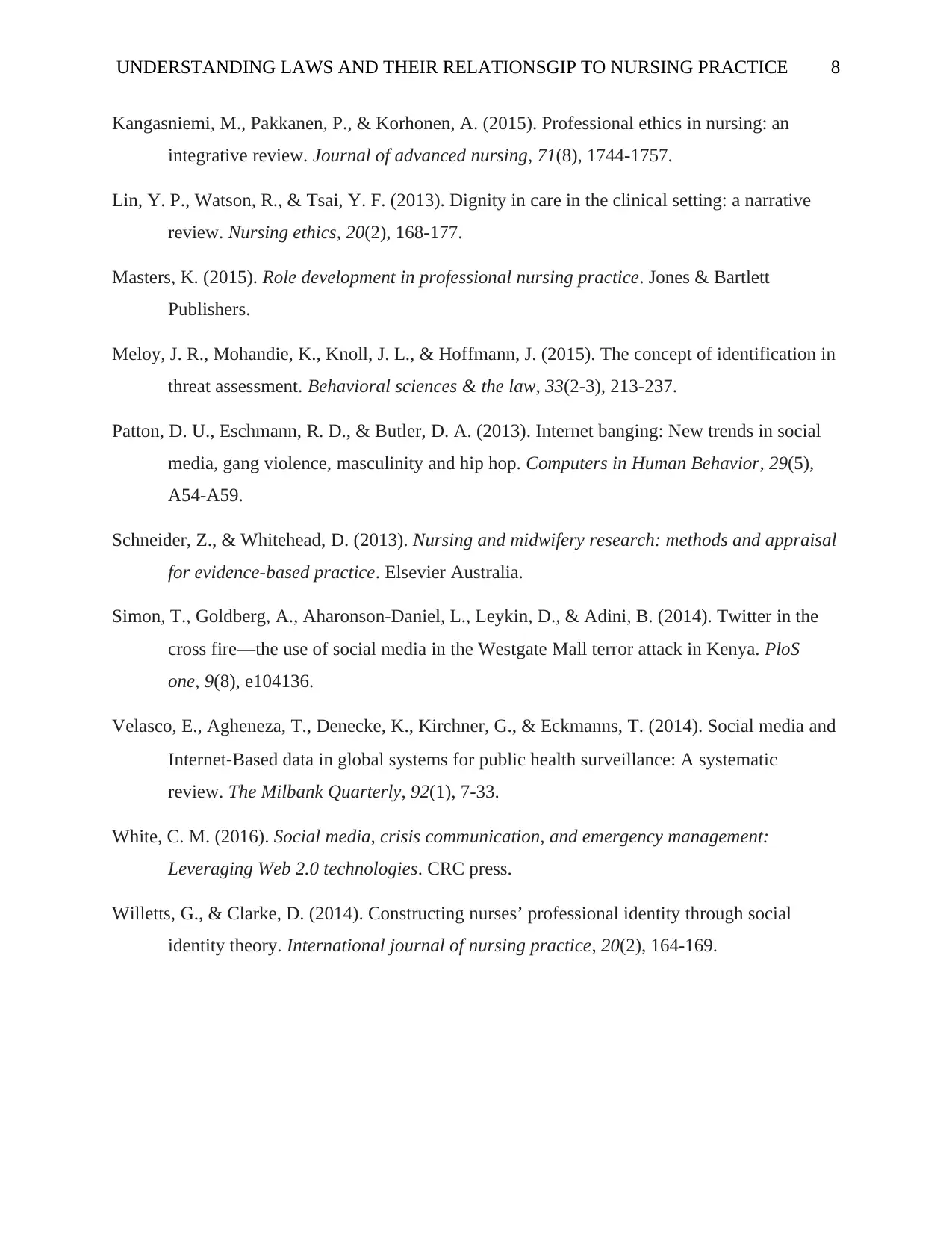
UNDERSTANDING LAWS AND THEIR RELATIONSGIP TO NURSING PRACTICE 8
Kangasniemi, M., Pakkanen, P., & Korhonen, A. (2015). Professional ethics in nursing: an
integrative review. Journal of advanced nursing, 71(8), 1744-1757.
Lin, Y. P., Watson, R., & Tsai, Y. F. (2013). Dignity in care in the clinical setting: a narrative
review. Nursing ethics, 20(2), 168-177.
Masters, K. (2015). Role development in professional nursing practice. Jones & Bartlett
Publishers.
Meloy, J. R., Mohandie, K., Knoll, J. L., & Hoffmann, J. (2015). The concept of identification in
threat assessment. Behavioral sciences & the law, 33(2-3), 213-237.
Patton, D. U., Eschmann, R. D., & Butler, D. A. (2013). Internet banging: New trends in social
media, gang violence, masculinity and hip hop. Computers in Human Behavior, 29(5),
A54-A59.
Schneider, Z., & Whitehead, D. (2013). Nursing and midwifery research: methods and appraisal
for evidence-based practice. Elsevier Australia.
Simon, T., Goldberg, A., Aharonson-Daniel, L., Leykin, D., & Adini, B. (2014). Twitter in the
cross fire—the use of social media in the Westgate Mall terror attack in Kenya. PloS
one, 9(8), e104136.
Velasco, E., Agheneza, T., Denecke, K., Kirchner, G., & Eckmanns, T. (2014). Social media and
Internet‐Based data in global systems for public health surveillance: A systematic
review. The Milbank Quarterly, 92(1), 7-33.
White, C. M. (2016). Social media, crisis communication, and emergency management:
Leveraging Web 2.0 technologies. CRC press.
Willetts, G., & Clarke, D. (2014). Constructing nurses’ professional identity through social
identity theory. International journal of nursing practice, 20(2), 164-169.
Kangasniemi, M., Pakkanen, P., & Korhonen, A. (2015). Professional ethics in nursing: an
integrative review. Journal of advanced nursing, 71(8), 1744-1757.
Lin, Y. P., Watson, R., & Tsai, Y. F. (2013). Dignity in care in the clinical setting: a narrative
review. Nursing ethics, 20(2), 168-177.
Masters, K. (2015). Role development in professional nursing practice. Jones & Bartlett
Publishers.
Meloy, J. R., Mohandie, K., Knoll, J. L., & Hoffmann, J. (2015). The concept of identification in
threat assessment. Behavioral sciences & the law, 33(2-3), 213-237.
Patton, D. U., Eschmann, R. D., & Butler, D. A. (2013). Internet banging: New trends in social
media, gang violence, masculinity and hip hop. Computers in Human Behavior, 29(5),
A54-A59.
Schneider, Z., & Whitehead, D. (2013). Nursing and midwifery research: methods and appraisal
for evidence-based practice. Elsevier Australia.
Simon, T., Goldberg, A., Aharonson-Daniel, L., Leykin, D., & Adini, B. (2014). Twitter in the
cross fire—the use of social media in the Westgate Mall terror attack in Kenya. PloS
one, 9(8), e104136.
Velasco, E., Agheneza, T., Denecke, K., Kirchner, G., & Eckmanns, T. (2014). Social media and
Internet‐Based data in global systems for public health surveillance: A systematic
review. The Milbank Quarterly, 92(1), 7-33.
White, C. M. (2016). Social media, crisis communication, and emergency management:
Leveraging Web 2.0 technologies. CRC press.
Willetts, G., & Clarke, D. (2014). Constructing nurses’ professional identity through social
identity theory. International journal of nursing practice, 20(2), 164-169.
1 out of 8
Related Documents
Your All-in-One AI-Powered Toolkit for Academic Success.
+13062052269
info@desklib.com
Available 24*7 on WhatsApp / Email
![[object Object]](/_next/static/media/star-bottom.7253800d.svg)
Unlock your academic potential
Copyright © 2020–2025 A2Z Services. All Rights Reserved. Developed and managed by ZUCOL.





